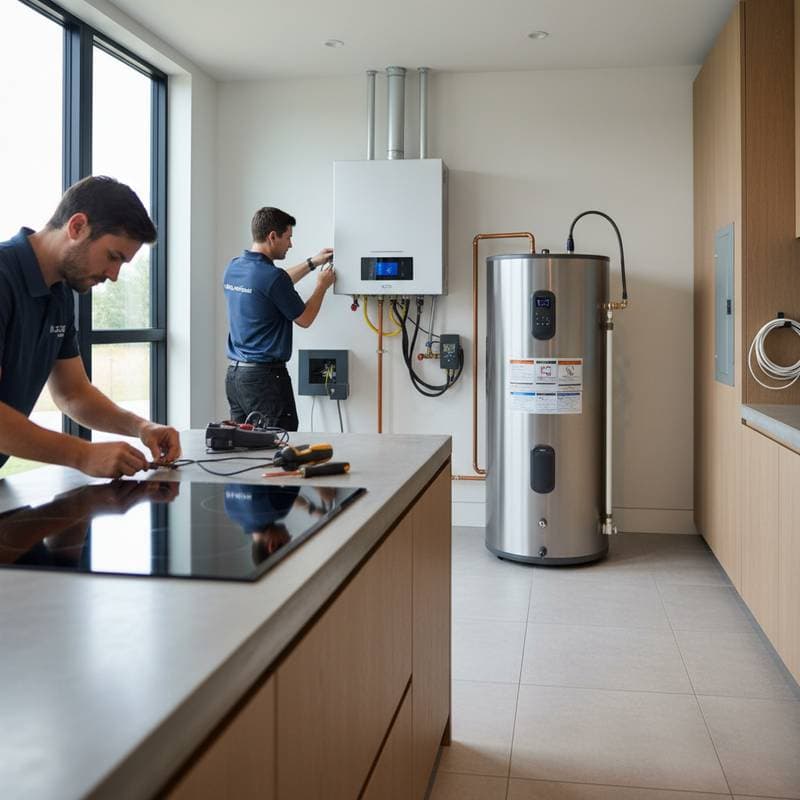Why 2025 Marks the Ideal Time for Induction Home Electrification
Homeowners often envision an ideal kitchen with smooth surfaces, intelligent devices, and cooking that combines ease with accuracy. Induction technology realizes this vision while lowering energy expenses and promoting a healthier indoor atmosphere. For those who have delayed the transition to electric cooking, 2025 provides compelling reasons to proceed.
Essential Advantages
- Induction cooktops decrease cooking energy consumption by up to 30 percent relative to conventional electric coils and by almost 70 percent compared to gas stoves.
- Installation expenses have declined by approximately 25 percent in recent years, thanks to stabilized supply chains and increased market demand.
- Federal and state programs offer incentives that cover up to 50 percent of costs for new induction appliances or electrical system enhancements.
- Induction delivers rapid heat adjustment, steady temperature regulation, and superior indoor air quality.
- The electromagnetic design keeps surfaces cool, minimizing burn hazards and enhancing safety for households with children.
Transitioning to Cleaner Cooking Methods
Electrifying homes has evolved from a distant idea into a sensible strategy against escalating energy costs, environmental concerns, and demands for improved indoor health. Gas stoves, previously favored by dedicated cooks, now receive criticism for emitting nitrogen dioxide and methane, pollutants that compromise air quality. Public health research indicates that gas stove usage in homes can elevate indoor pollutant concentrations beyond acceptable outdoor levels during routine meal preparation.
Induction addresses these challenges completely. It employs magnetic fields to warm pots and pans directly, avoiding any combustion process. Consequently, emissions drop, gas leak risks vanish, and the cooking area becomes more pleasant. Families dealing with respiratory conditions or sensitivities often observe improvements shortly after the change.
Understanding the Core Technology
Induction cooking operates on electromagnetic induction principles. An alternating current flows through a copper coil under the glass surface when compatible cookware is positioned above it, creating a fluctuating magnetic field. This field activates iron particles within the cookware, generating heat precisely where needed rather than dissipating it into the surrounding space.
Such efficiency stands out prominently. Studies by the Electric Power Research Institute reveal that induction cooktops achieve over 85 percent energy-to-heat conversion, surpassing gas stoves at about 35 percent. Home cooks benefit from quicker boiling, uniform browning, and minimal energy loss as a result.
Evaluating Cooking Alternatives
| Feature | Induction | Gas | Standard Electric Coil |
|---|---|---|---|
| Energy Efficiency | High (85%+) | Moderate (35%) | Moderate (65%) |
| Temperature Control | Instant and Precise | Delayed | Slower |
| Air Quality | No Emissions | Produces NO2 and CO | No Emissions |
| Safety | Surface Stays Cool | Open Flame | Hot Surface |
| Maintenance | Easy Cleaning | Requires Ventilation | Moderate Cleaning |
This overview highlights induction's appeal to both professional chefs and everyday users. The technology now matches or surpasses gas in speed and control. Features like cool-touch surfaces and automatic shutoff further suit homes with young children or older adults.
Incentives and Cost Benefits
Expense has long deterred adoption of induction systems. Recent developments erode this hurdle. Expanded manufacturing lowers prices, while governmental initiatives provide rebates and tax credits for electrification efforts. In various locations, these supports reimburse 25 to 50 percent of acquisition and setup costs for induction ranges or full kitchen conversions.
The economic rationale extends further. Data from the U.S. Department of Energy suggest that induction reduces yearly cooking energy use by about one-third. Across the appliance's service life, savings may reach several hundred dollars, especially when paired with sources such as solar panels.
Installation Essentials
Evaluate your kitchen's power setup prior to installation. Induction units typically demand a 240-volt dedicated circuit, akin to that for an electric dryer. Electricians can add this for a modest fee, often reduced during bundled upgrades if wiring requires attention.
Most induction models work with magnetic cookware, so test existing items with a magnet for compatibility. Non-magnetic pieces may need replacement, but many households already possess suitable options. For those in rentals or hesitant about major changes, portable induction units connect to standard outlets and allow trial without commitment.
Broader Impacts on Environment and Daily Life
Adopting induction extends beyond convenience to environmental contributions. Each conversion from gas to electric diminishes residential carbon output. Projections from the International Energy Agency indicate that widespread home electrification could halve emissions from buildings in coming decades.
Daily benefits enhance living quality significantly. Kitchens remain cooler with reduced ambient heat. Spills clean easily without hardening on hot surfaces. The process grows quieter and more straightforward, fostering a more enjoyable home routine.
Steps to Upgrade Your Kitchen
Start by reviewing local rebate programs through utility providers or government sites. Consult a certified electrician to inspect your electrical panel and estimate upgrade needs. Select induction models certified for efficiency, ensuring they fit your cookware and space requirements. With planning, the switch positions your home for efficiency, safety, and sustainability in 2025.










